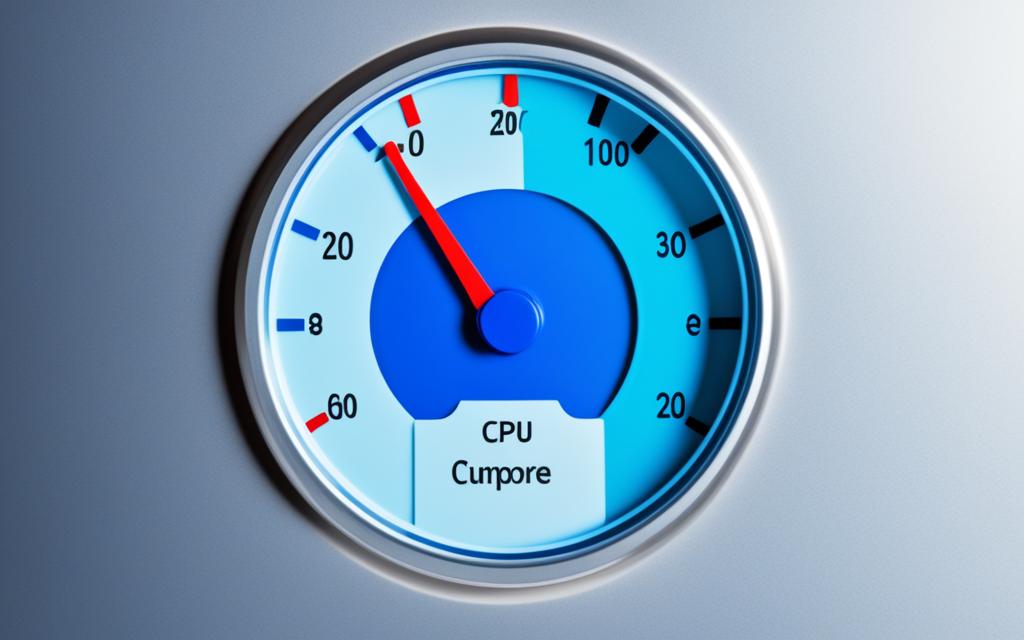Table of Contents
Knowing the right temperature range for your CPU is key. It helps keep your system running smoothly for longer. CPUs can get as hot as 80°C (176°F) when they’re working hard. But, they should stay cooler than that to avoid overheating and damage. Understanding the safe temperatures lets you use the right cooling solutions.
High temperatures over time can cause problems for the CPU and other parts. Generally, CPU temperatures should be between 40–65°C for everyday tasks. For heavier loads, temperatures can reach 70-80°C1. If they go above 80-85°C1, it’s time to check your cooling system. Keeping an eye on the temperatures is crucial, especially when using your computer for demanding tasks.
By knowing these guidelines, you can act to keep your computer stable and efficient. This reduces overheating risks and helps your system last longer. For tips on checking your CPU temperature, look into tools like Core Temp and NZXT’s CAM here.
Key Takeaways
- Optimal CPU temperatures should ideally range between 40–65°C during normal workloads.
- CPU temperature can peak at 70–80°C during intensive tasks but should not remain above 80°C for long.
- Monitoring tools like Core Temp and NZXT’s CAM are crucial for tracking real-time CPU temperatures.
- Proper cooling solutions can significantly enhance hardware longevity and performance.
- Regular temperature checks help prevent serious issues like system instability and crashes.
Understanding CPU Temperature
Getting to grips with CPU temperature is key for keeping a computer running well. This temperature is the heat made by the central processing unit while it works. It shows if the CPU is healthy and working right. A normal temperature for when it’s not doing much is 30°C (86°F) to 40°C (104°F)2.
When the computer is just on, the CPU’s temperature usually stays between 30°C and 40°C (86°F to 104°F). But, when it’s working hard, it can get between 60°C and 70°C (140°F to 158°F)2.
What is CPU Temperature?
The heat of the CPU is important to watch, as it links to how well the CPU works. Most new CPUs can work up to 80°C (176°F) without trouble. However, for the best performance and to last longer, it’s better to keep it cooler2. If the CPU often goes over 80°C, it could start working poorly and might get damaged over time2.
The Importance of CPU Temperature in System Performance
Keeping an eye on the temperature helps stop the computer from getting too hot and keeps it stable. This is really important when doing things like gaming or streaming. While doing these, the CPU should stay between 70°C (158°F) and 80°C (176°F)2.
It’s especially critical to monitor the CPU’s heat during heavy use. Aim to keep it below 80°C (176°F) for safety2.
What is a Good CPU Temperature?
Knowing good CPU temperatures is key for top performance and long life. It’s important to keep temperatures within safe ranges. This is because it ties directly to how well the CPU works. Tasks vary, so do temperature needs.
Safe Operating Ranges for Different Tasks
For light tasks like surfing the web and simple office work, CPUs should stay between 30°C and 40°C (86°F to 104°F). When you play games or edit videos, temperatures can go up to 85°C. But for gaming, staying between 70°C and 80°C (158°F to 176°F)34 is best. These levels keep your system running well without risk of overheating.
Ideal Idle and Load Temperatures
When not in use, a good CPU temperature is under 50°C. While doing heavy tasks, it’s best to keep it under 70°C. Going over 80°C often can harm your computer over time45. Below is a quick guide for different CPU activities:
| Activity Level | Idle (°C) | Load (°C) | Max (°C) |
|---|---|---|---|
| Light Usage | 30-40 | Under 70 | 85 |
| Gaming/Intensive Work | 50 | 60-80 | 85 |
| Overloading | Above 50 | Above 85 | 90+ |
Good cooling, like top CPU coolers and effective case fans, improves thermal performance. They help you keep your CPU at the right temperatures for your needs.
For more on CPU temperature control, check out this article. It gives detailed advice on keeping temperatures safe345.
How Hot Should My CPU Get?
Knowing your CPU’s safe temperature is key to keeping it running well. The safe limit for modern CPUs is about 85°C (185°F) during hard work like gaming. Going over this can cause big problems, like slow performance or even damage to your CPU.
Defining Maximum Safe Limits
Different tasks mean different safe temperatures. For games, it’s best to keep below 80°C (176°F), with an ideal range of 75°C to 80°C (167°F to 176°F)6. AMD’s Ryzen and other modern CPUs turn off if they get too hot. This stops them from getting damaged7.
Consequences of High CPU Temperatures
If your CPU stays too hot for too long, it can cause big problems. It will work slower and might not be reliable. You might see strange things on your screen, crashes, or the parts might not last as long because of the heat7. It’s very important to keep an eye on how hot your CPU gets. Cleaning your computer and using good cooling can help avoid these issues.
How to Check Your CPU Temperature
It’s important to keep an eye on your CPU temperature to ensure it’s running well. You can check your CPU temperature in several ways. These include using built-in BIOS tools or third-party software. Doing so helps maintain your processor’s performance and lifespan.
Using Built-in BIOS/UEFI Tools
One easy way to monitor your CPU temperature is through the BIOS. When you start your computer, you can enter the BIOS/UEFI by pressing a specific key. This is usually shown on the boot screen. However, this method only shows the temperature at startup, not in real-time8.
In the BIOS, temperature info is often found under “PC Health Status” or “Hardware Monitor.” A common idle temperature for CPUs is around 50°C. This is helpful to know for checking temperatures when your computer is not doing much8.
Third-Party Software Recommendations
If you want more detailed CPU temperature info, there are many software options. Programs like Core Temp, HWMonitor, and NZXT’s Cam let you monitor in real-time. This is useful for seeing temperature changes during things like games. Such monitoring is key9.
These tools show how temperatures change, helping spot potential overheating. CPUs usually stay between 45-100°C. Going over this range could mean your CPU is too hot9.
| Software | Key Features | Best For |
|---|---|---|
| Core Temp | Detailed CPU temperature readings, logging features | Users requiring in-depth CPU statistics |
| HWMonitor | Overview of system health, including temperatures and voltages | General usage and monitoring all hardware |
| NZXT’s Cam | User-friendly interface, comprehensive monitoring tools | Gamers and enthusiasts seeking visual performance tracking |
Common Causes of High CPU Temperatures
Knowing what causes high CPU temperatures helps keep computers running well. Overclocking, dust, poor airflow, and bad cooling systems are common issues. They can lower your CPU’s performance and life. By spotting these problems, you can find good solutions.
Overclocking Effects
Overclocking makes a CPU run faster than designed. It boosts performance but causes more heat. Too much heat without control can harm the CPU. Users should watch out for the dangers of high heat.
Dust and Poor Ventilation
Dust can block airflow and make a computer overheat. This can slow down your computer or cause it to turn off10. Poor airflow adds to the issue, particularly when the computer is working hard. It’s important to keep your computer clean and airy.
Faulty Cooling Systems
Bad cooling systems can’t move heat away from the CPU well. Clean your computer, change thermal paste, and check if coolers are working to avoid this. For better cooling, consider getting a high-quality cooler. This will help control CPU heat. For more tips, visit Panda Security’s guide on managing CPU temperatures.
FAQ
What is the safe CPU temperature range?
Typically, a CPU should be between 30°C and 40°C (86°F to 104°F) when your computer is not doing much. When it’s working hard, temperatures can jump to between 60°C and 80°C (140°F to 176°F). It’s best to keep the temperature under 70°C (158°F) to ensure your computer runs well for a long time.
How can I monitor my CPU temperature effectively?
You can check your CPU temperature right from the BIOS/UEFI tools for quick readings. Or, you can use third-party programs like Core Temp, NZXT’s Cam, and HWinfo. They give you constant updates and detailed information on how hot your CPU is.
What are the consequences of high CPU temperatures?
Too much heat can make your computer unstable or cause it to crash. It can even slow down your computer or damage it permanently. That’s why it’s important to keep an eye on how hot your CPU gets.
What factors can lead to CPU overheating?
Overclocking your CPU makes it hotter. Dust can also block the air that cools your computer. If your computer case doesn’t allow for good airflow, or if your cooling system isn’t working well (like a bad fan or old thermal paste), your CPU might overheat.
What temperature should I expect when running demanding applications?
If you’re gaming or editing videos, your CPU can get as hot as 70°C to 80°C (158°F to 176°F). But, it’s crucial to watch the temperature to make sure it doesn’t stay too high and harm your computer.
How does CPU temperature impact overall system performance?
If your CPU gets too hot, it will slow itself down to cool off. This process is called thermal throttling. When this happens, your computer might not work as well or as fast as it should, affecting both how you use it and its reliability.
Source Links
- https://www.avast.com/c-how-to-check-cpu-temperature – How to Check and Monitor Your CPU Temperature
- https://www.noyafa.com/blogs/knowledge-base/good-cpu-temperature – What Is A Good CPU Temperature? A Guide to Keep Your Processor Cool
- https://directmacro.com/blog/post/what-is-optimal-cpu-and-gpu-temp – What Is Optimal GPU Temp and CPU Temperature Range
- https://gadgetmates.com/normal-cpu-gpu-temperatures-for-your-pc – Normal CPU & GPU Temperatures For Your PC – GadgetMates
- https://www.linkedin.com/advice/3/what-normal-optimal-ranges-cpu-temperature-different – What are the normal and optimal ranges of CPU temperature for different types of processors?
- https://gamebooster.itopvpn.com/cpu-and-gpu-temp-monitor.php – How to monitor CPU & GPU temperature when gaming in real time?
- https://www.techadvisor.com/article/726264/whats-the-best-cpu-temperature.html – What’s the best temperature for your CPU?
- https://www.tomshardware.com/how-to/how-to-check-cpu-temp-temperature – How to Check Your CPU Temperature
- https://softwarekeep.com/blogs/how-to/how-to-check-cpu-temp-in-windows-10-11 – How To Check Your CPU Temperature in Windows 10/11
- https://www.linkedin.com/advice/1/how-can-you-lower-your-cpu-temperature-too-high – How can you lower your CPU temperature if it is too high or overheating?








